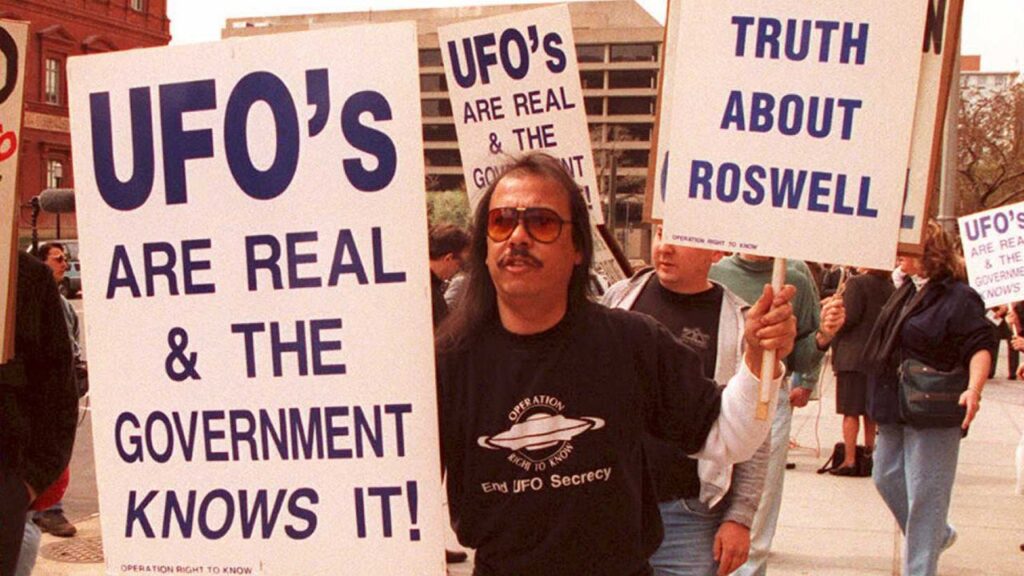On June 24, 1997, a significant event occurred in the history of the U.S. Air Force. A 232-page report titled “The Roswell Report: Case Closed” was released, shedding light on a mysterious incident near Roswell, New Mexico, which some believe to be a UFO crash-landing on Earth. This report was the second part of the government’s official disclosure about what transpired in rural New Mexico in the 1940s. Prior to this, in 1994, the government had published “The Roswell Report: Fact vs. Fiction in the New Mexico Desert.” The release of these reports aimed to provide a comprehensive explanation of the events that occurred many years ago in the Southwest.
The foreword of the 1997 report was written by Secretary of the Air Force Sheila A. Widnall, who highlighted the significance of the “Roswell Incident” in American folklore. She stated that the Air Force played a crucial role in investigating the events surrounding Roswell in the 1940s. Widnall emphasized the government’s commitment to uncovering all records related to the incident and bringing them to public light. The objective of the inquiry was clear – to find all the facts and present them in an open and transparent manner. With the publication of “The Roswell Report: Case Closed,” Widnall believed that the goal of providing a complete explanation of the events in the Southwest had been achieved.
The report detailed the events that unfolded on June 14, 1947, when rancher W.W. (“Mac”) Brazel made a startling discovery on his ranch, located approximately 80 miles northwest of Roswell. Brazel described the wreckage he found as consisting of rubber strips, tinfoil, tough paper, and sticks. Perplexed by this discovery, Brazel left the debris untouched for around two weeks before eventually gathering all the materials on July 4. He then brought the wreckage to the sheriff of Roswell, George Wilcox, who, in turn, contacted Colonel “Butch” Blanchard, the commander of the Roswell Army Airfield’s 509th Composite Group, for further investigation. Blanchard, unable to decipher the nature of the debris, sought the assistance of General Roger W. Ramey, his superior.
Ramey, stationed in Fort Worth, Texas, almost 500 miles away from Roswell, was also puzzled by the strange discovery. Additionally, Blanchard enlisted the help of Major Jesse Marcel, an intelligence officer, to inspect the wreckage further. Marcel, Brazel, and Wilcox revisited Brazel’s ranch to conduct a thorough investigation. As the team tried to ascertain the materials’ origin, Marcel chose to make a public statement which was published in the local newspaper, the Roswell Daily Record, on July 8. The headline of the paper read, “RAAF Captures Flying Saucer on Ranch in Roswell,” sparking intense interest and speculation regarding the extraterrestrial nature of the discovery.
The revelation that the RAAF possessed an alien spacecraft set off a frenzy, with the public captivated by the possibility of an extraterrestrial presence. However, the subsequent attempt by the military to backtrack on the narrative by citing the wreckage as a high-altitude weather balloon dampened the excitement. It was later revealed that the debris found on Brazel’s ranch was part of Project Mogul, a classified program that involved launching high-altitude balloons into the ionosphere to monitor Soviet nuclear tests. This revelation brought an end to the speculation surrounding the Roswell incident.
Despite the debunking of the UFO theory, Roswell has since embraced its association with the extraterrestrial phenomenon. The city features an alien on its official seal, and a sign welcoming visitors depicts a cow being abducted by a flying saucer. Roswell has become a hub for UFO enthusiasts, hosting an annual “UFO Festival” in July, with the International UFO Museum & Research Center attracting visitors curious about the city’s extraterrestrial connections. The city’s tourism website offers official merchandise featuring flying saucers and other alien motifs, catering to the enduring fascination with the Roswell incident.
Overall, the events of June 24, 1997, marked a significant chapter in the history of the U.S. Air Force and the enduring legacy of the Roswell incident. The release of the report aimed to provide transparency and closure regarding the mysterious events of the 1940s, shedding light on a fascinating period in American history that continues to captivate the public imagination to this day.












